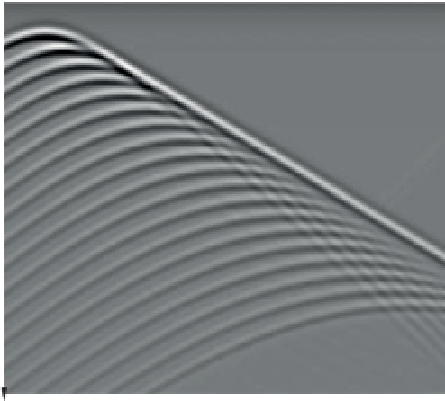Geoscience Reference
In-Depth Information
data
fits a hyperboloid travel time surface to a 2D distribu-
tion of trace locations, i.e. a data volume (
Fig. 6.25
).
a)
Location (
X
)
1 spacing
Dom
Diffractors approximating reflector
Pre-stack migration and dip-moveout processing
Stacking assumes horizontal re
ectors, although it will
work reasonably well with dipping horizons provided they
all have similar dips. In a hard-rock environment, where
contrary dips are to be expected, NMO and stacking act as
a dip-filter, preserving arrivals from reflectors dipping in
one direction and suppressing those from features dipping
in the opposite direction. When the reflector dips towards
the source the stacking velocity will be higher than the
actual velocity, and vice versa, so the correct velocity for
flattening an event dipping in one direction will be signifi-
cantly different from that which will
Location (
X
)
1/2 spacing
Dom
Location (
X
)
1/4
spacing
Dom
flatten an event dip-
ping in the opposite direction. Events with similar dips
stack fairly well, but at the expense of suppressing those
with different dips.
As a general rule, if velocities and structure are suffi-
-
ciently complex that re
ections do not have their
Location (
X
)
1/8 spacing
Dom
'
curvilinear moveout, then pre-stack migration is required.
Pre-stack is conceptually the same as post-stack migration
but must account for the fact that the data are in
finite-
offset form, so the travel time curves of the arrivals are
different than for the equivalent zero-offset data. A major
disadvantage of pre-stack migration is that the data
volumes are much larger because it precedes the combin-
ing of multiple traces into one equivalent zero offset trace.
That is, the data volume is larger by a factor equal to the
fold of the stack. Migration is a computationally intense
process so this is a significant disadvantage. An alternative
approach is called dip-moveout (DMO), which is a partial
migration that is applied after correcting for NMO so that
subsequent stacking preserves all arrivals regardless of
dip. The preservation of the dipping events means that
post-stack migration will produce results that are more
realistic. A description of DMO and pre-stack migration
is beyond our scope. A straightforward demonstration of
the equivalence of pre-stack migration and DMO+post-
'
usual
b)
Location (
X
)
1/4 spacing
Dom
Apparent reflector
Figure 6.23
Are
ector represented as a series of closely spaced
diffractors with the spacing speci
ed in terms of the dominant
wavelength (
λ
Dom
) of the seismic signal. (a) Horizontal re
ector with
diffractor spacing decreasing, and (b) dipping re
ector. The seismic
velocity in the model used to create the seismic data is 2 km/s, so that
the TWT and depth scales are equivalent, allowing diffractors to be
overlaid on the seismic data.
Time and depth migration
Whether implemented pre- or post-stack, two basic classes
of migration are recognised based on their assumptions
about velocity variations in the subsurface. In time migra-
tion, as implemented in diffraction-summation migration,
only variations in velocity directly above the hypothetical
applied to 3D data. Instead of identifying samples in a line
(1D) of traces, constituting a section, that are intersected
by a hyperbolic travel time curve, migration of 3D seismic



















































































Search WWH ::

Custom Search